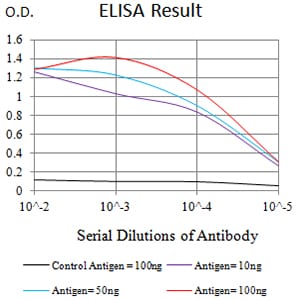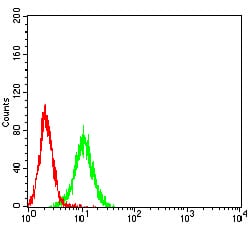

| WB | 咨询技术 | Human,Mouse,Rat |
| IF | 咨询技术 | Human,Mouse,Rat |
| IHC | 咨询技术 | Human,Mouse,Rat |
| ICC | 技术咨询 | Human,Mouse,Rat |
| FCM | 1/200 - 1/400 | Human,Mouse,Rat |
| Elisa | 1/10000 | Human,Mouse,Rat |
| Aliases | VSIG9; VSTM3; WUCAM |
| Entrez GeneID | 201633 |
| clone | 4C5B9 |
| WB Predicted band size | 26.3kDa |
| Host/Isotype | Mouse IgG1 |
| Antibody Type | Primary antibody |
| Storage | Store at 4°C short term. Aliquot and store at -20°C long term. Avoid freeze/thaw cycles. |
| Species Reactivity | Human |
| Immunogen | Purified recombinant fragment of human TIGIT (AA: extra 22-141) expressed in E. Coli. |
| Formulation | Purified antibody in PBS with 0.05% sodium azide |
+ +
以下是3-4篇关于TIGIT抗体的代表性文献,简要总结如下:
---
1. **"Tiragolumab plus atezolizumab in patients with non-small cell lung cancer: A phase II trial"**
*作者:Cho BC, et al. (2020)*
**摘要**:该Ⅱ期临床试验显示,TIGIT抗体Tiragolumab联合PD-L1抑制剂阿替利珠单抗,显著提高PD-L1高表达晚期非小细胞肺癌患者的客观缓解率,支持TIGIT与PD-1/PD-L1联合阻断的协同抗肿瘤效果。
2. **"Co-blockade of TIGIT and PD-1 enhances antitumor immunity"**
*作者:Johnston RJ, et al. (2019)*
**摘要**:通过小鼠模型研究发现,TIGIT抗体与PD-1抑制剂联合使用可增强CD8⁺ T细胞功能,抑制调节性T细胞(Treg)活性,显著减少肿瘤生长,为临床联合免疫治疗提供理论依据。
3. **"TIGIT limits immune responses during chronic viral infection and cancer"**
*作者:Banta KL, et al. (2021)*
**摘要**:研究揭示TIGIT在抗PD-1耐药性中的作用,发现TIGIT抗体可逆转肿瘤微环境中T细胞耗竭,并抑制Treg介导的免疫抑制,尤其在PD-1耐药模型中表现出治疗潜力。
4. **"Anti-TIGIT antibody promotes antitumor immunity by modulating both effector and regulatory T cells"**
*作者:Chauvin JM, et al. (2018)*
**摘要**:临床前研究表明,TIGIT抗体单药或联合PD-1阻断可增强效应T细胞的细胞毒性,同时降低Treg的免疫抑制功能,显著抑制黑色素瘤和结肠癌模型中的肿瘤进展。
---
以上文献涵盖临床前机制探索和临床试验,聚焦TIGIT抗体在增强抗肿瘤免疫及联合治疗中的应用。如需具体期刊页码或DOI,可进一步补充关键词或研究细节。
TIGIT (T cell immunoreceptor with Ig and ITIM domains) is an inhibitory immune checkpoint receptor expressed on T cells and natural killer (NK) cells. It belongs to the CD28 family and binds to ligands such as CD155 (PVR), CD112 (PVRL2), and CD113 (PVRL3), which are often overexpressed on tumor cells and antigen-presenting cells. TIGIT suppresses immune activation by competing with the co-stimulatory receptor CD226 for ligand binding, thereby dampening T/NK cell-mediated antitumor responses. Its signaling involves recruitment of phosphatases like SHIP1 to inhibit downstream pathways, reducing cytokine production and cytotoxic activity.
Therapeutic targeting of TIGIT aims to reverse this immunosuppression. Preclinical studies show that anti-TIGIT antibodies, either alone or in combination with PD-1/PD-L1 inhibitors, enhance antitumor immunity by restoring T/NK cell function. This synergy arises from TIGIT and PD-1 operating through non-redundant pathways. Clinical trials are evaluating anti-TIGIT agents (e.g., tiragolumab, vibostolimab) in cancers like NSCLC, with mixed phase III results highlighting the need for biomarker-driven patient selection. Challenges include understanding resistance mechanisms and optimizing combination strategies. Despite setbacks, TIGIT remains a promising target in immuno-oncology due to its role in regulating adaptive and innate antitumor immunity.
×